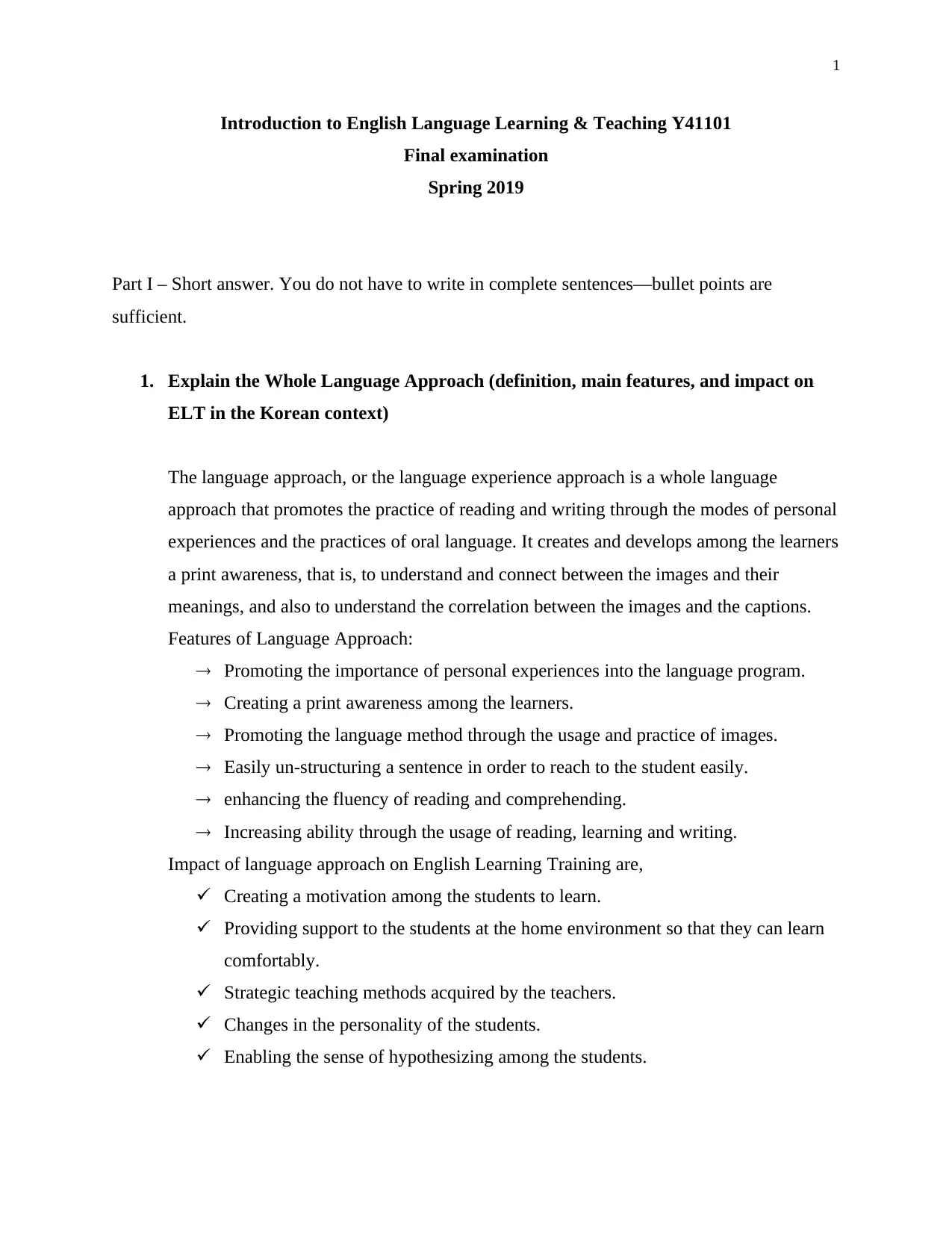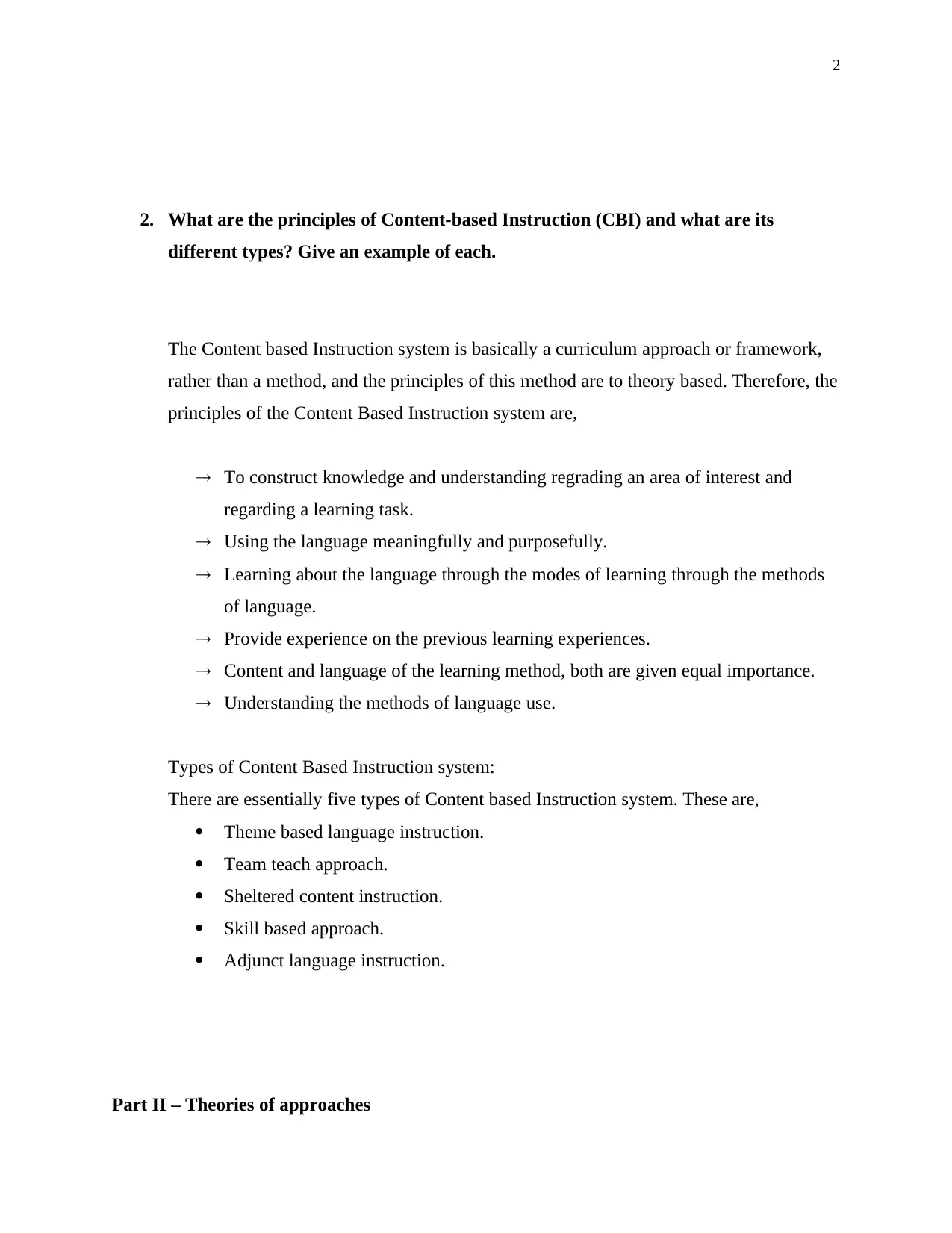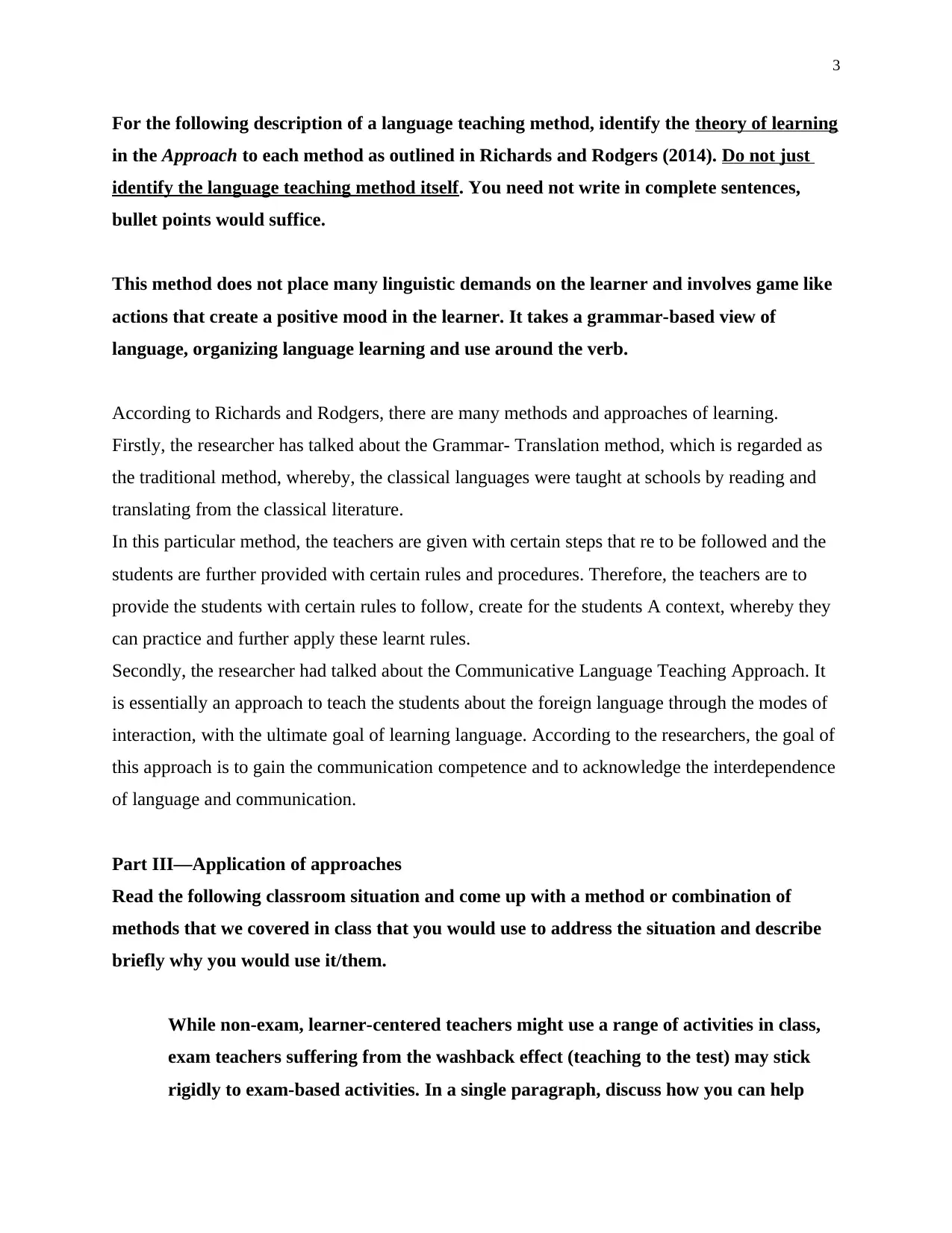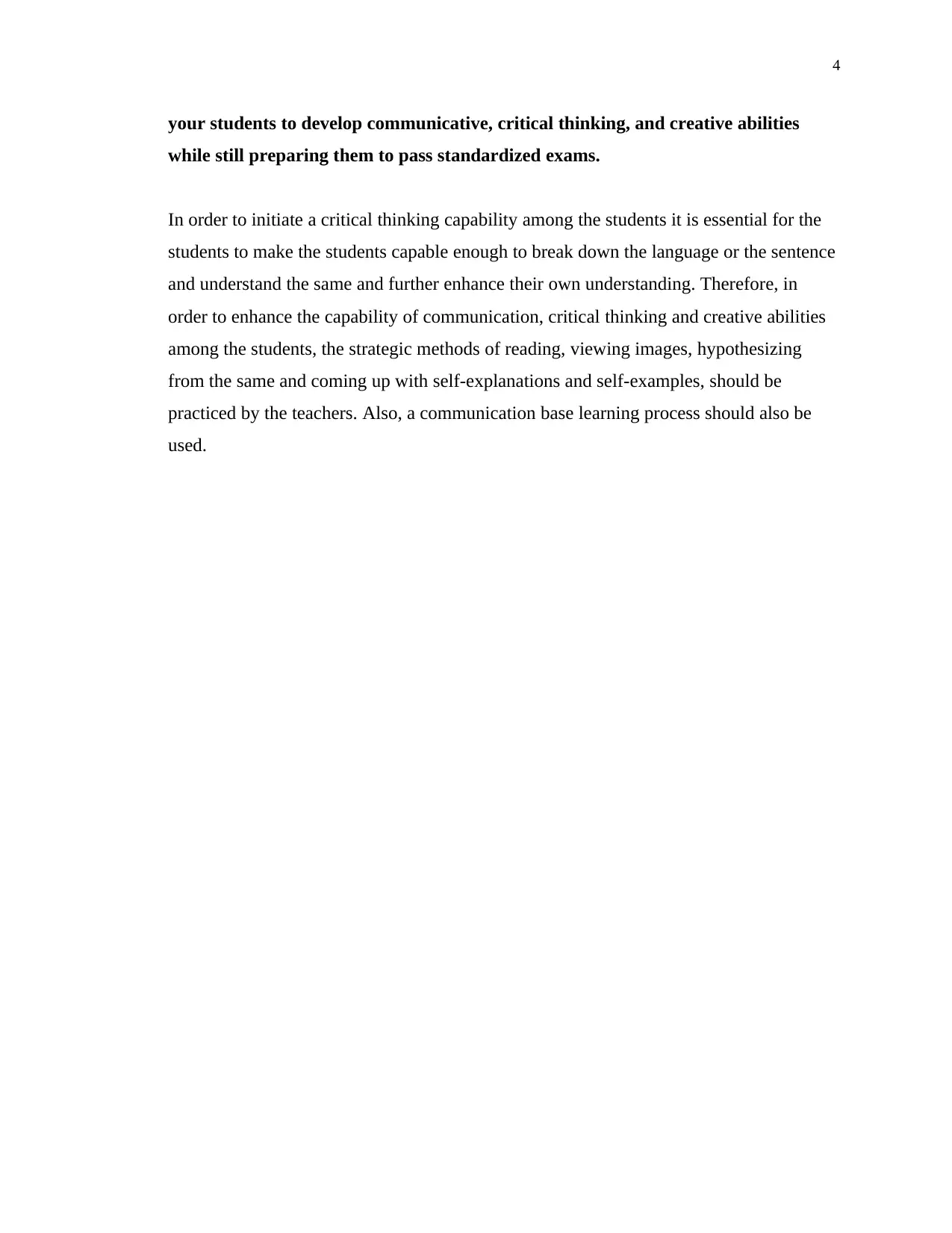Y41101 Final Exam: English Language Teaching, Spring 2019
VerifiedAdded on 2022/12/19
|4
|945
|36
Homework Assignment
AI Summary
This document provides a comprehensive set of solutions for the Introduction to English Language Learning & Teaching Y41101 final examination from Spring 2019. The solutions cover Part I, which includes explanations of the Whole Language Approach, its features, and its impact on English Language Teaching (ELT) in the Korean context, along with principles and types of Content-based Instruction (CBI). Part II identifies the theories of learning in various language teaching methods described. Part III addresses a classroom situation, proposing a combination of teaching methods to develop students' communicative, critical thinking, and creative abilities while preparing them for standardized exams. The solutions emphasize the importance of integrating different teaching strategies to enhance student learning and exam performance.

1
Introduction to English Language Learning & Teaching Y41101
Final examination
Spring 2019
Part I – Short answer. You do not have to write in complete sentences—bullet points are
sufficient.
1. Explain the Whole Language Approach (definition, main features, and impact on
ELT in the Korean context)
The language approach, or the language experience approach is a whole language
approach that promotes the practice of reading and writing through the modes of personal
experiences and the practices of oral language. It creates and develops among the learners
a print awareness, that is, to understand and connect between the images and their
meanings, and also to understand the correlation between the images and the captions.
Features of Language Approach:
Promoting the importance of personal experiences into the language program.
Creating a print awareness among the learners.
Promoting the language method through the usage and practice of images.
Easily un-structuring a sentence in order to reach to the student easily.
enhancing the fluency of reading and comprehending.
Increasing ability through the usage of reading, learning and writing.
Impact of language approach on English Learning Training are,
Creating a motivation among the students to learn.
Providing support to the students at the home environment so that they can learn
comfortably.
Strategic teaching methods acquired by the teachers.
Changes in the personality of the students.
Enabling the sense of hypothesizing among the students.
Introduction to English Language Learning & Teaching Y41101
Final examination
Spring 2019
Part I – Short answer. You do not have to write in complete sentences—bullet points are
sufficient.
1. Explain the Whole Language Approach (definition, main features, and impact on
ELT in the Korean context)
The language approach, or the language experience approach is a whole language
approach that promotes the practice of reading and writing through the modes of personal
experiences and the practices of oral language. It creates and develops among the learners
a print awareness, that is, to understand and connect between the images and their
meanings, and also to understand the correlation between the images and the captions.
Features of Language Approach:
Promoting the importance of personal experiences into the language program.
Creating a print awareness among the learners.
Promoting the language method through the usage and practice of images.
Easily un-structuring a sentence in order to reach to the student easily.
enhancing the fluency of reading and comprehending.
Increasing ability through the usage of reading, learning and writing.
Impact of language approach on English Learning Training are,
Creating a motivation among the students to learn.
Providing support to the students at the home environment so that they can learn
comfortably.
Strategic teaching methods acquired by the teachers.
Changes in the personality of the students.
Enabling the sense of hypothesizing among the students.
Paraphrase This Document
Need a fresh take? Get an instant paraphrase of this document with our AI Paraphraser

2
2. What are the principles of Content-based Instruction (CBI) and what are its
different types? Give an example of each.
The Content based Instruction system is basically a curriculum approach or framework,
rather than a method, and the principles of this method are to theory based. Therefore, the
principles of the Content Based Instruction system are,
To construct knowledge and understanding regrading an area of interest and
regarding a learning task.
Using the language meaningfully and purposefully.
Learning about the language through the modes of learning through the methods
of language.
Provide experience on the previous learning experiences.
Content and language of the learning method, both are given equal importance.
Understanding the methods of language use.
Types of Content Based Instruction system:
There are essentially five types of Content based Instruction system. These are,
Theme based language instruction.
Team teach approach.
Sheltered content instruction.
Skill based approach.
Adjunct language instruction.
Part II – Theories of approaches
2. What are the principles of Content-based Instruction (CBI) and what are its
different types? Give an example of each.
The Content based Instruction system is basically a curriculum approach or framework,
rather than a method, and the principles of this method are to theory based. Therefore, the
principles of the Content Based Instruction system are,
To construct knowledge and understanding regrading an area of interest and
regarding a learning task.
Using the language meaningfully and purposefully.
Learning about the language through the modes of learning through the methods
of language.
Provide experience on the previous learning experiences.
Content and language of the learning method, both are given equal importance.
Understanding the methods of language use.
Types of Content Based Instruction system:
There are essentially five types of Content based Instruction system. These are,
Theme based language instruction.
Team teach approach.
Sheltered content instruction.
Skill based approach.
Adjunct language instruction.
Part II – Theories of approaches

3
For the following description of a language teaching method, identify the theory of learning
in the Approach to each method as outlined in Richards and Rodgers (2014). Do not just
identify the language teaching method itself. You need not write in complete sentences,
bullet points would suffice.
This method does not place many linguistic demands on the learner and involves game like
actions that create a positive mood in the learner. It takes a grammar-based view of
language, organizing language learning and use around the verb.
According to Richards and Rodgers, there are many methods and approaches of learning.
Firstly, the researcher has talked about the Grammar- Translation method, which is regarded as
the traditional method, whereby, the classical languages were taught at schools by reading and
translating from the classical literature.
In this particular method, the teachers are given with certain steps that re to be followed and the
students are further provided with certain rules and procedures. Therefore, the teachers are to
provide the students with certain rules to follow, create for the students A context, whereby they
can practice and further apply these learnt rules.
Secondly, the researcher had talked about the Communicative Language Teaching Approach. It
is essentially an approach to teach the students about the foreign language through the modes of
interaction, with the ultimate goal of learning language. According to the researchers, the goal of
this approach is to gain the communication competence and to acknowledge the interdependence
of language and communication.
Part III—Application of approaches
Read the following classroom situation and come up with a method or combination of
methods that we covered in class that you would use to address the situation and describe
briefly why you would use it/them.
While non-exam, learner-centered teachers might use a range of activities in class,
exam teachers suffering from the washback effect (teaching to the test) may stick
rigidly to exam-based activities. In a single paragraph, discuss how you can help
For the following description of a language teaching method, identify the theory of learning
in the Approach to each method as outlined in Richards and Rodgers (2014). Do not just
identify the language teaching method itself. You need not write in complete sentences,
bullet points would suffice.
This method does not place many linguistic demands on the learner and involves game like
actions that create a positive mood in the learner. It takes a grammar-based view of
language, organizing language learning and use around the verb.
According to Richards and Rodgers, there are many methods and approaches of learning.
Firstly, the researcher has talked about the Grammar- Translation method, which is regarded as
the traditional method, whereby, the classical languages were taught at schools by reading and
translating from the classical literature.
In this particular method, the teachers are given with certain steps that re to be followed and the
students are further provided with certain rules and procedures. Therefore, the teachers are to
provide the students with certain rules to follow, create for the students A context, whereby they
can practice and further apply these learnt rules.
Secondly, the researcher had talked about the Communicative Language Teaching Approach. It
is essentially an approach to teach the students about the foreign language through the modes of
interaction, with the ultimate goal of learning language. According to the researchers, the goal of
this approach is to gain the communication competence and to acknowledge the interdependence
of language and communication.
Part III—Application of approaches
Read the following classroom situation and come up with a method or combination of
methods that we covered in class that you would use to address the situation and describe
briefly why you would use it/them.
While non-exam, learner-centered teachers might use a range of activities in class,
exam teachers suffering from the washback effect (teaching to the test) may stick
rigidly to exam-based activities. In a single paragraph, discuss how you can help
⊘ This is a preview!⊘
Do you want full access?
Subscribe today to unlock all pages.

Trusted by 1+ million students worldwide

4
your students to develop communicative, critical thinking, and creative abilities
while still preparing them to pass standardized exams.
In order to initiate a critical thinking capability among the students it is essential for the
students to make the students capable enough to break down the language or the sentence
and understand the same and further enhance their own understanding. Therefore, in
order to enhance the capability of communication, critical thinking and creative abilities
among the students, the strategic methods of reading, viewing images, hypothesizing
from the same and coming up with self-explanations and self-examples, should be
practiced by the teachers. Also, a communication base learning process should also be
used.
your students to develop communicative, critical thinking, and creative abilities
while still preparing them to pass standardized exams.
In order to initiate a critical thinking capability among the students it is essential for the
students to make the students capable enough to break down the language or the sentence
and understand the same and further enhance their own understanding. Therefore, in
order to enhance the capability of communication, critical thinking and creative abilities
among the students, the strategic methods of reading, viewing images, hypothesizing
from the same and coming up with self-explanations and self-examples, should be
practiced by the teachers. Also, a communication base learning process should also be
used.
1 out of 4
Related Documents
Your All-in-One AI-Powered Toolkit for Academic Success.
+13062052269
info@desklib.com
Available 24*7 on WhatsApp / Email
![[object Object]](/_next/static/media/star-bottom.7253800d.svg)
Unlock your academic potential
Copyright © 2020–2025 A2Z Services. All Rights Reserved. Developed and managed by ZUCOL.





